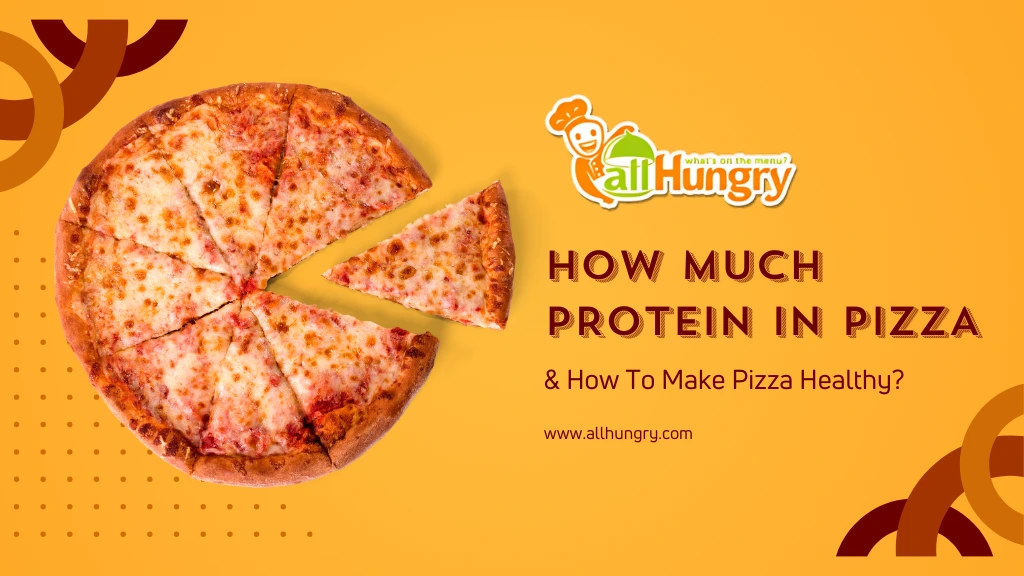How Much Protein in Pizza & How to Make Pizza Healthy?
A standard slice of cheese pizza typically contains around 12 grams of protein. The amount can vary depending on the type of crust, cheese and toppings used. For example, a large slice from Costco’s cheese pizza has around 16 grams of protein, all thanks to its and this portion.
If you’re wondering How Much Protein in Pizza with meat toppings, the number goes up. A slice of 14-inch pepperoni pizza contains around 13 grams of protein, making it a higher-protein option compared to plain cheese.
How Much Protein in Pizza & How To Make Pizza Healthy? This depends on your choice of crust, cheese, and toppings, which can boost or balance its nutritional value.
How to make your pizza protein-rich and healthy?
1. Choose a high-protein Crust
Traditional pizza crusts are primarily composed of refined flour, offering minimal protein content. To boost the protein content, you can consider using whole-grain or alternative flour crusts. For example, a crust made with Greek yoghurt and self-rising flour can provide a high-protein base.
2. Go for lean proteins
Topping your pizza with clean proteins can improve the nutritional value and also add flavour. Turkey pepperoni, grilled chicken can be excellent choices, full of stuff, these options are lower in fat as compared to traditional pepperoni, making your pizza healthier.
3. Incorporate high-protein cheese
Cheese is a major source of protein in pizza. Opting for part-skim mozzarella or adding a sprinkle of parmesan can increase the content without adding excessive fat. Some recipes even suggest blending cottage cheese into the dough for an extra protein boost.
4. Load up on vegetables
Vegetables are nutritious and also add texture and flavour to your pizza. Toppings like spinach, bell peppers, onions and mushrooms are rich in vitamins, minerals and fibre.
Furthermore, blending white beans into the sauce can increase its protein and fibre content without changing the taste.
5. Mind the sauce
The type of sauce you use can impact the healthiness of your pizza. Going for a tomato-based sauce is a better choice as compared to cream-based sauces like Alfredo, which are higher and fat and calories. Tomato sauce is rich in antioxidants and vitamins, making it a heart-healthy option.
Pizza as a means for active lifestyles
Making pizza at home allows you to measure and add the exact amount of protein that you need. For example, home-cooked pizza with high-protein dough and beans can add up to 50 to 60 grams of protein per meal. After a workout, the body needs protein to repair muscles.
A protein-rich pizza slice paired with a side of Greek yogurt can be a satisfying recovery meal. Furthermore, pizza can be protein-heavy, but don’t forget about other macro nutrients, including vegetables for fibre, healthy fats from seeds or olive oil, and a whole grain crust ensures that our pizza meal is balanced and nutritious.
Nutritional overview of pizza
| Pizza Type | Protein per Slice | Notes |
| Standard Cheese Pizza | ~12g | Average protein content |
| Costco Cheese Pizza Slice | ~16g | Higher protein due to extra cheese |
| Pepperoni Pizza Slice | ~13g | Additional protein from pepperoni |
| High-Protein Homemade Pizza | 30–70g | Varies based on ingredients and recipe |
Fun protein pizza variations
If you are planning to eat pizza and breakfast, you can top it with eggs or low-fat cheese. Mediterranean pizza can also be eaten with hummus as the base and grilled chicken or olives.
You can use vegan protein pizza as a mid-meal by using nutritional yeast. Each variation allows you to customize protein levels according to your taste and diet requirements while keeping the pizza exciting.
High protein topping ideas and combinations
Grilled chicken, bell Peppers spinach provide lean protein and fiber. Seafood sensations like shrimp or smoked salmon on a whole grain crust or an amazing source of protein and omega-3 fatty acids. Mediterranean protein pizza, like tofu and olives, provides a plant-based option that is rich in protein and minerals. Mixing and matching these toppings allows you to control protein content while keeping flavour exciting.
Smart tips to make pizza healthier without losing taste
- 1 easy way to enjoy pizza without overloading on calories is by controlling portion size. Instead of eating three large slices, have one or two and pair come with a side salad or steamed veggies.
- Traditional pepperoni and sausage are tasty but high in saturated fats. Switching to lean proteins like grilled chicken can drastically cut fat while keeping the protein high.
- You can even boost your pizza with nutrient-dense toppings like spinach and broccoli, as they add fibre, vitamins and minerals. You can sprinkle some seeds, like pumpkin or sunflower seeds, on top to increase the protein and healthy fats.
- Store-bought sauces can be high in sugar and sodium content. A simple tomato-based sauce made at home with fresh tomatoes is healthier and naturally rich in antioxidants.
- Cheese is the main protein source in pizza, but some varieties are high in fat. Part-skim mozzarella or ricotta can provide protein while reducing fat content.
Conclusion
Pizza doesn’t have to be a guilty pleasure. By making mindful choices in your crust toppings and sauces, you can create a delicious, protein-rich meal that aligns with your health goals. Just remember, moderation is the key and enjoying a slice of nutritious pizza from allHungry can be satisfying and beneficial.


No Comment